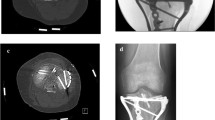Abstract
Introduction
Moore type II Entire Condyle fractures of the tibia plateau represent a rare and highly unstable fracture pattern that usually results from high impact traumas. Specific recommendations regarding the surgical treatment of these fractures are sparse. We present a series of Moore type II fractures treated by open reduction and internal fixation through a direct dorsal approach.
Patients and methods
Five patients (3 females, 2 males) with Entire Condyle fractures were retrospectively analyzed after a mean follow-up period of 39 months (range 12–61 months). Patient mean age at the time of operation was 36 years (range 26–43 years). Follow-up included clinical and radiological examination. Furthermore, all patient finished a SF36 and Lysholm knee score questionnaire.
Results
Average range of motion was 127/0/1° with all patients reaching full extension at the time of last follow up. Patients reached a mean Lysholm score of 81.2 points (range 61–100 points) and an average SF36 of 82.36 points (range 53.75–98.88 points). One patient sustained deep wound infection after elective implant removal 1 year after the initial surgery. Overall all patients were highly satisfied with the postoperative result.
Conclusion
The direct dorsal approach to the tibial plateau represents an adequate method to enable direct fracture exposure, open reduction, and internal fixation in posterior shearing medial Entire Condyle fractures and is especially valuable when also the dorso-lateral plateau is depressed.


Similar content being viewed by others
References
Moore TM (1981) Fracture-dislocation of the knee. Clin Orthop Relat Res 156:128–140
Müller M, Nazarian S, Koch P, Schatzker J (1990) The comprehensive classification of fractures of long bones. Springer, Berlin, pp 120–121
Schatzker J, McBroom R, Bruce D (1979) The tibial plateau fracture. The Toronto experience 1968–1975. Clin Orthop Relat Res 138:94–104
Bullinger M, Kirchberger I (1998) SF36 questionnaire concerning health status. Hogrefe, Göttingen
Lysholm J, Gillquist J (1982) Evaluation of knee ligament surgery results with special emphasis on use of a scoring scale. Am J Sports Med 10(3):150–154. doi:10.1177/036354658201000306
Barei DP, Nork SE, Mills WJ, Coles CP, Henley MB, Benirschke SK (2006) Functional outcomes of severe bicondylar tibial plateau fractures treated with dual incisions and medial and lateral plates. J Bone Joint Surg Am 88(8):1713–1721
Blokker CP, Rorabeck CH, Bourne RB (1984) Tibial plateau fractures. An analysis of the results of treatment in 60 patients. Clin Orthop Relat Res 182:193–199
Brown TD, Anderson DD, Nepola JV, Singerman RJ, Pedersen DR, Brand RA (1988) Contact stress aberrations following imprecise reduction of simple tibial plateau fractures. J Orthop Res 6(6):851–862
Colletti P, Greenberg H, Terk MR (1996) MR findings in patients with acute tibial plateau fractures. Comput Med Imaging Graph 20(5):389–394
Dirschl DR, Del Gaizo D (2007) Staged management of tibial plateau fractures. Am J Orthop 36(Suppl 4):12–17
Stallenberg B, Gevenois PA, Sintzoff SA Jr, Matos C, Andrianne Y, Struyven J (1993) Fracture of the posterior aspect of the lateral tibial plateau: radiographic sign of anterior cruciate ligament tear. Radiology 187(3):821–825
Moore TM, Patzakis MJ, Harvey JP (1987) Tibial plateau fractures: definition, demographics, treatment rationale, and long-term results of closed traction management or operative reduction. J Orthop Trauma 1(2):97–119
Young MJ, Barrack RL (1994) Complications of internal fixation of tibial plateau fractures. Orthop Rev 23(2):149–154
Fernandez DL (1988) Anterior approach to the knee with osteotomy of the tibial tubercle for bicondylar tibial fractures. J Bone Joint Surg Am 70(2):208–219
Schatzker J (1988) Fractures of the tibial plateau, vol 1. Lippincott, Philadelphia, pp 421–434
Bhattacharyya T, McCarty LP 3rd, Harris MB, Morrison SM, Wixted JJ, Vrahas MS, Smith RM (2005) The posterior shearing tibial plateau fracture: treatment and results via a posterior approach. J Orthop Trauma 19(5):305–310
Carlson DA (2005) Posterior bicondylar tibial plateau fractures. J Orthop Trauma 19(2):73–78
De Boeck H, Opdecam P (1995) Posteromedial tibial plateau fractures. Operative treatment by posterior approach. Clin Orthop Relat Res 320:125–128
Galla M, Lobenhoffer P (2003) The direct, dorsal approach to the treatment of unstable tibial posteromedial fracture-dislocations. Unfallchirurg 106(3):241–247
Fakler JK, Ryzewicz M, Hartshorn C, Morgan SJ, Stahel PF, Smith WR (2007) Optimizing the management of Moore type I postero-medial split fracture dislocations of the tibial head: description of the Lobenhoffer approach. J Orthop Trauma 21(5):330–336. doi:10.1097/BOT.0b013e318055603c
Trickey EL (1968) Rupture of the posterior cruciate ligament of the knee. J Bone Joint Surg Br 50(2):334–341
Partenheimer A, Gosling T, Muller M, Schirmer C, Kaab M, Matschke S, Ryf C, Renner N, Wiebking U, Krettek C (2007) Management of bicondylar fractures of the tibial plateau with unilateral fixed-angle plate fixation. Unfallchirurg 110(8):675–683
Gerich T, Blauth M, Witte F, Krettek C (2001) Osteosynthesis of fractures of the head of the tibia in advanced age. A matched-pair analysis. Unfallchirurg 104(1):50–56
Author information
Authors and Affiliations
Corresponding author
Rights and permissions
About this article
Cite this article
Brunner, A., Honigmann, P., Horisberger, M. et al. Open reduction and fixation of medial Moore type II fractures of the tibial plateau by a direct dorsal approach. Arch Orthop Trauma Surg 129, 1233–1238 (2009). https://doi.org/10.1007/s00402-009-0841-9
Received:
Published:
Issue Date:
DOI: https://doi.org/10.1007/s00402-009-0841-9




